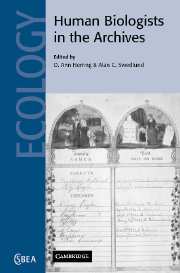 Human Biologists in the Archives
Human Biologists in the Archives Book contents
- Frontmatter
- Contents
- Contributors
- Foreword by Sydel Silverman and Michael A. Little
- Acknowledgements
- 1 Human biologists in the archives: demography, health, nutrition and genetics in historical populations
- 2 The use of archives in the study of microevolution: changing demography and epidemiology in Escazú, Costa Rica
- 3 Anthropometric data and population history
- 4 For everything there is a season: Chumash Indian births, marriages, and deaths at the Alta California missions
- 5 Children of the poor: infant mortality in the Erie County Almshouse during the mid nineteenth century
- 6 Worked to the bone: the biomechanical consequences of ‘labor therapy’ at a nineteenth century asylum
- 7 Monitored growth: anthropometrics and health history records at a private New England middle school, 1935–1960
- 8 Scarlet fever epidemics of the nineteenth century: a case of evolved pathogenic virulence?
- 9 The ecology of a health crisis: Gibraltar and the 1865 cholera epidemic
- 10 War and population composition in Åland, Finland
- 11 Infectious diseases in the historical archives: a modeling approach
- 12 Where were the women?
- 13 Malnutrition among northern peoples of Canada in the 1940s: an ecological and economic disaster
- 14 Archival research in physical anthropology
- Index
- References
12 - Where were the women?
Published online by Cambridge University Press: 12 August 2009
- Frontmatter
- Contents
- Contributors
- Foreword by Sydel Silverman and Michael A. Little
- Acknowledgements
- 1 Human biologists in the archives: demography, health, nutrition and genetics in historical populations
- 2 The use of archives in the study of microevolution: changing demography and epidemiology in Escazú, Costa Rica
- 3 Anthropometric data and population history
- 4 For everything there is a season: Chumash Indian births, marriages, and deaths at the Alta California missions
- 5 Children of the poor: infant mortality in the Erie County Almshouse during the mid nineteenth century
- 6 Worked to the bone: the biomechanical consequences of ‘labor therapy’ at a nineteenth century asylum
- 7 Monitored growth: anthropometrics and health history records at a private New England middle school, 1935–1960
- 8 Scarlet fever epidemics of the nineteenth century: a case of evolved pathogenic virulence?
- 9 The ecology of a health crisis: Gibraltar and the 1865 cholera epidemic
- 10 War and population composition in Åland, Finland
- 11 Infectious diseases in the historical archives: a modeling approach
- 12 Where were the women?
- 13 Malnutrition among northern peoples of Canada in the 1940s: an ecological and economic disaster
- 14 Archival research in physical anthropology
- Index
- References
Summary
Introduction
Understanding the lives of women in medieval Britain (a period spanning roughly the twelfth through the sixteenth centuries) has a been a subject of interest and research for some time. Insights into numerous aspects of women's lives have been made through the use of documentary sources. For instance, early contributions by Abram (1916), Dale (1933), and Thrupp (1948), as well as more recent contributions by Power (1975), Charles and Duffin (1985), Hanawalt (1986), Goldberg (1991, 1992, 1995), Rosenthal (1990) and Jewell (1996) explore women's socioeconomic roles and contributions through the arclysis of many types of documentary evidence, including parish church records, poll tax returns, legal documents, and literary sources, to name a few. The interplay between women and law has also been evaluated for a considerable number of years (see Abram 1916; Sheehan 1963; Cannon 1999), as have medieval women's private and family roles (see Goody 1983; Goldberg 1991; Hanawalt 1986; Kowaleski 1988), women and medicine (see Greene 1989–90, 1994), and women and religion (Power 1922; Thompson 1991; Jewell 1996).
Using historical documents to understand the lives of medieval women, however, has well-recognized limitations. In England, for instance, church records of births, marriages, baptisms, and deaths were not made compulsory until 1538 (Palliser 1979). Prior to that, records were seldom kept, or were kept by particular families or wealthy parishes. Similarly, the use of tombstones did not become a popular means of marking graves and/or providing information about the deceased until the seventeenth century (Johnson 1912).
- Type
- Chapter
- Information
- Human Biologists in the ArchivesDemography, Health, Nutrition and Genetics in Historical Populations, pp. 266 - 288Publisher: Cambridge University PressPrint publication year: 2002
References
- 1
- Cited by


